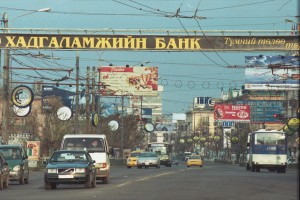 Ulaanbaatar, the capital city of Mongolia is situated in the valley of Tuul river surrounded by Bogd, Bayanzurkh, Songino and Chingeltei mountains. The altitude of Ulaanbaatar is 1351 meters. Ulaanbaatar occupies 135.800 hectares and has almost half of the country’s population. There are 8 districts in the city such as: Bayangol, Bayanzurkh, Songinokhairkhan, Chingeltei, Sukhbaatar, Khan-Uul, Nalaikh and Baganuur.
Ulaanbaatar, the capital city of Mongolia is situated in the valley of Tuul river surrounded by Bogd, Bayanzurkh, Songino and Chingeltei mountains. The altitude of Ulaanbaatar is 1351 meters. Ulaanbaatar occupies 135.800 hectares and has almost half of the country’s population. There are 8 districts in the city such as: Bayangol, Bayanzurkh, Songinokhairkhan, Chingeltei, Sukhbaatar, Khan-Uul, Nalaikh and Baganuur.
Two of them, Nalaikh and Baganuur, are located 35km and 150km away respectively from Ulaanbaatar. The capital city is the country’s scientific, industrial, educational, cultural, political and economic center. It has the State Circus, Drama theater, Opera and ballet theater, many kinds of museums and universities. Ulaanbaatar is called a student’s city because there are about 100 state and private universities and institutes. The state’s biggest universities are the National University of Mongolia, the Mongolian University of Science and Technology, and the Finance and Economic institute. The center of Ulaanbaatar is Sukhbaatar square which is surrounded by the Government Palace, Bodi tower and World Trade Tower.
The name of the city has changed many times. It has been Orgoo, Nomiin Khuree, Ikh Khuree, Da Khuree, Niislel Khuree and finally Ulaanbaatar. After the people’s revolution, it was named Ulaanbaatar. The history of Mongolian capital city is related to Khar Khorin which is located in Uvurkhangai province. According to some records, Khar khorin was built in 1220. It was the capital city of Mongolia for 32 years in the Mongolian empire. During that time, many travelers, including Marco polo, visited the city. The city was moved from one place to another more than 20 times.
The figures and indicators of the 2004 General Guidelines of Socio-Economics of Ulaanbaatar city were compared with the year 2000. According to the comparison, the Capital’s population has increased by 160 thousand and Gross Domestic Product by 54.6 percent. The amount of the GDP per person has increased by 37.3 percent. A minimum income of households has also risen by 518 percent, and domestic investments 2.8 times. Ulaanbaatar city accumulates one third of the State Central Budget. Per last years survey by the Road and Transportation Department of Ulaanbaatar reveals that 150,000 people daily use the public transportation out of 300,000 total passengers in Ulaanbaatar, the most crowded settlement of the country.
New socio-economic trends have dramatically expanded the role of the capital city in the development of Mongolia. Taking into account the present situation, the parliament has adopted the “Law of Mongolia on the Legal Status of the Capital City” on July 5th, 1994. Foreign relations of UB have also considerably developed. The city now has friendly relations with the following cities: Denver, CO, USA; Tokyo, Osaka and Sapporo, Japan; Munich, Germany; Florence, Italy; St. Petersburg, Russia; Tianjin, China; Ankara, Turkey; and Seoul, South Korea. Ulaanbaatar has brotherhood ties with more than 36 foreign cities.








2 Responses to “Ulaanbaatar Capital City”